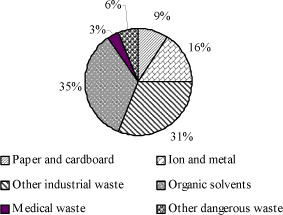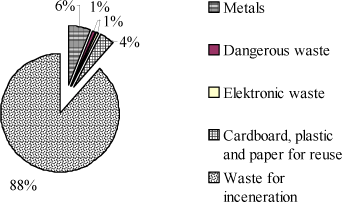|
| Forside | | Indhold | | Forrige | | Næste |
Udpegning og kortlægning af affaldstunge brancher
Summary and conclusions
Through the project a detailed survey on volumes and types of waste within selected activities from the pharmaceutical industry, the electronic industry, iron and metal industry and the furniture industry in
Denmark. The industries have been selected based on an environmental priority and the surveyed volumes have also been assessed.
Background and Objective
Today, there does not exist a total general view on where the largest and most significant volumes of waste are generated. Part of the present knowledge is gathered in ISAG, however, the level of details
does not include the possibility for companies and authorities to suggest new types of waste minimization and/or waste treatment.
The objective of the project has been to obtain and assess knowledge on waste volumes from manufacturing industries within essential trades and industrial sectors. It was decided to focus exclusively on
manufacturing industries as initiatives had already been made within the service sector and the building and construction sector.
The purpose of the first phase of the project was to make a screening method for selection of significant flows of waste and to make a preliminary selection of significant industrial sectors.
In the second phase of the project the purpose was to map out the volumes and types of waste from the selected industries. The method was to be adjusted to each single industry and the possibilities to
gather data and process existing data.
The Study
The first phase of the study was that a group key figures with a solid knowledge on all conditions of production within manufacturing industry and persons with knowledge on waste discussed and prioritsed
the most significant industrial sectors.
Prior to the prioritisation it was determined what can be described as ”significant volumes of waste”. The prioritisation includes parameters such as volumes in general and pr. company and the composition of
the waste – which materials did the waste consist of and which potential environmental impact was attached to the waste.
After selecting the relevant industrial sectors and trades the survey was carried out very differently in each branch. In some trades it was possible to gather data from surveys carried out recently, in others the
gathering of data was based on questionnaires, telephone interviews and/or visits to companies and contact to selected experts/persons.
Principal Results
The principal results of the project are divided into three subjects
- A method to point out or compare the waste fractions within different industries
- A selection of significant spheres in which future efforts should be considered. The prioritised spheres are small pharmaceutical and electronic manufacturers, the furniture sector and the sectors
sandblasting, galvanic coating, weldment and usage of cooling agents and lubricants within the ion and metal sector
- A survey of volumes and types of waste within the prioritised sectors divided into types of waste and an assessment of disposal methods of each single flow of waste.
Partial Results
The Pharmaceutical Industry
Small pharmaceutical industries primarily undertakes formulation and packing of medical products. Mindre farmaceutiske virksomheder beskæftiger sig primært med formulering og pakning af medicinske
produkter. They pose about 100 companies.
The survey was made up based on phone and written questionnaires..
The industry produces in the area of 6,000 ton waste pr. year. A little over half of waste is industrial waste and a little below is dangerous waste.

Electronic Industry
The sector is defined to include electronic assembling companies manufacturing circuit boards and completed electronics in small series sand companies manufacturing electronic components. The sector
includes totally 31 companies.
The industry produces 2,000-2,500 ton waste pr. year. The majority consists of waste for incineration and includes corrugated cardboard and cardboard and paper and plastic.

The Ion and Metal Sector
Regarding sand blasting the focus is on cleaning of steel and zinc-coated steel. The volume of waste is about 30,000 ton, of which 2,000 ton are cleaned material in the fractions of residues of paint, metals
from the product and others.
The metal finishing industry includes approx. 100 companies dealing with cleaning and plating of metals. The waste in the shape of metal sludge consisting of nickel, chrom, copper, zinc, zinc stannum, ion and
aluminium is about 2,000 ton pr. year.
Welding electrodes are used in different processes and for different purposes. They primarily consist of alloy steel, other metals including aluminium and different additives such as quartz. The annual
consumption is approx. 9,000 ton of which 1/3 is produced as waste.
Cooling agents and lubricants are widely used within the ion and metal sector. Water-based and water-free agents are partly used. Water-based agents represent by far the largest part and discarded agents
represent 4-8,000 ton pr. year. As for water-free agents the volume of waste is approx. 200 ton pr. year.
The Furniture sector
For the survey of the furniture sector the focus was on gluing and vanishing at the manufacturing of furniture and kitchen units chosen.
Approx. 8-9,000 ton of vanish are used and the volume of waste is about 10%. The most significant types of vanish are acid hardening vanish, water-based vanish and UV-hardening vanish.
About 7,000 ton of glue is used and the volume of waste is about 5 %. The most significant types of adhersives are polymer dispersioner and reactive systems.
Environmental Assessment
At the environmental assessment it turned out that the polluting flows of waste appear in the ion and metal sector. Especially, the metal finishing industry represents relatively large volumes of waste consisting
of heavy metals, which are difficult to reclaim.
The volumes of waste, which have been survey within the other sectors, turned out to represent either small volumes of waste or relatively less polluting waste. Common to these volumes of waste it
appeared that the majority of the waste was disposed correctly either by processing or by incineration with energy recovery.
| Forside | | Indhold | | Forrige | | Næste | | Top |
Version 1.0 Januar 2006, © Miljøstyrelsen.
|